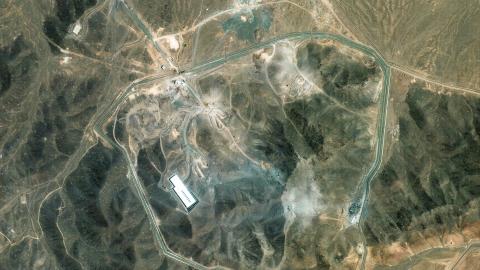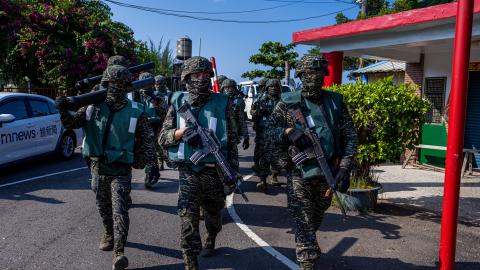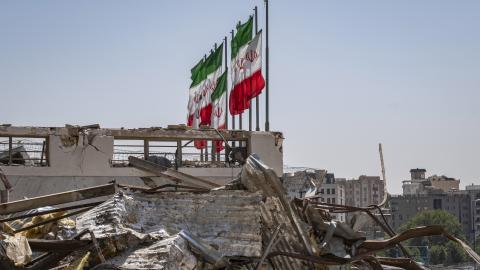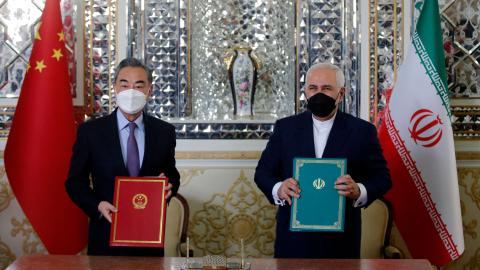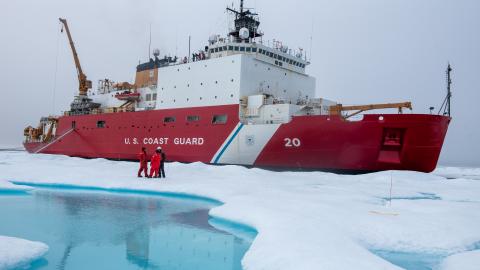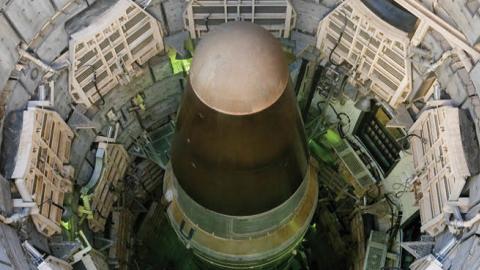Central to the effectiveness of U.S. strategic deterrence is convincing our enemies of our resolve to defend American vital interests from aggression with whatever combinations of weapons are necessary. Weapons within the arch of strategic deterrence include conventional and missile defenses, but the nuclear deterrent is the keystone.
The primary purpose of U.S. nuclear weapons, as expressed in the 2018 Nuclear Posture Review (NPR), is to deter a nuclear attack, whether small or large in scale, against a U.S. ally or the United States itself. But that is not their sole purpose. They are also intended to prevent large-scale conventional warfare that threatens U.S. vital interests, as well as a chemical and biological weapons attack, and provide assurances to allies who have chosen not to acquire their own nuclear capabilities, which is more conducive to preventing a nuclear exchange.
At the heart of effective nuclear deterrence is the credible threat that the United States is willing to employ nuclear weapons to defend its vital interests when absolutely necessary. By maintaining a force that could reliably contribute to terminating a war with as little damage as possible, should deterrence fail, on terms most favorable to the United States, the United States strengthens deterrence.
Since the end of the Cold War, the United States has sought to move away from nuclear weapons in its national defense strategy, and as recently as the Administration of President Barack Obama, U.S. leaders downplayed major-power conflict as a thing of the past.1 Regrettably, adversaries of the U.S. have not agreed and have invested in the weapons they deem most able to thwart U.S. aims and threaten U.S. security. The global threat environment is more complex and more dynamic than at any time since the end of the Cold War, and the peace that America has enjoyed for 70 years is tenuous.
There are many factors that have led us here, but the crux of the problem is that as our enemies become more able to challenge the United States, they simultaneously perceive an inverse correlation in the strength of American resolve to defend its stated vital national interests. Their doubt in U.S. resolve is abetting the deterioration of the credibility of strategic deterrence that has underpinned the post–World War Two order.
The United States, by failing to invest sufficiently in a modern nuclear enterprise and a reliable triad of modern nuclear delivery systems, has given adversaries reason to doubt. An American observer might enthusiastically disagree with the notion that American resolve has weakened, but what matters for deterrence is our adversaries’ perception of our resolve, and the United States has given them reason to doubt.
When the stakes are as high as they are, especially in the context of competition against two adversaries—China and Russia—contesting the United States in multiple theaters, the risk of a regional conventional conflict escalating with dire implications increases. While the focus of much public commentary is on how the United States ought to shift and add conventional firepower and defensive systems, we cannot miss the salience of the unique contributions of our nuclear deterrent in today’s dynamic threat context.
Our nuclear forces complement our conventional forces and provide a backstop to their use. Our nuclear deterrent signals to adversaries that should they decide to attack U.S. interests with conventional weapons and then escalate to a larger-scale conventional war with strategic effects, they will not be able to do so with a reasonable hope that the United States will ultimately back down. Our nuclear deterrent therefore strengthens the deterrent effect of our conventional weapons and strategies. This means that U.S. military planners and operators, whether they realize it or not, rely heavily on the effectiveness of nuclear deterrence when they project power in the face of our adversaries’ provocations and threats. Our nuclear deterrent is therefore in use every minute of every day, and the importance of the deterrent effect’s remaining sound cannot be overstated.
To demonstrate a real, as opposed to merely rhetorical, commitment to America’s nuclear deterrent and do so clearly, the United States must fully modernize its nuclear capabilities, especially given the actions of our adversaries. Failing to do this with a sense of urgency and willingness to adapt risks three major outcomes:
* Adversaries could employ nuclear weapons, whether in a regional context because they believe that a nuclear employment, however small in scale, will cause the United States to back down and sue for peace or, in the case of rogue nations, against U.S. soil.
* Adversaries could either initiate a conventional war against U.S. vital interests that could escalate to nuclear employment or employ chemical or biological weapons.
* Allies could doubt the U.S. commitment to their security and acquire their own nuclear weapons, tempting other nations to do the same and creating a far more precarious global security environment.
Adversaries Are Emphasizing Nuclear Weapons
The security environment continues to increase in complexity and volatility. While the thought of a nuclear exchange today might seem to some too horrible even to contemplate, it is a possibility, and we must think seriously about how we might prevent it. It is imperative that we take a clear-eyed assessment not only of other nations’ nuclear capabilities, but also of their national agendas as well as other factors such as the willingness of those who threaten the United States to threaten our way of life and the relative peace and security that the United States has helped to maintain for the past seven decades. It is only when we do this that we can most effectively deter major war and, should deterrence fail, win as quickly as possible on terms favorable to the United States.
China. The Chinese Communist Party (CCP), led by President Xi Jinping, has become more willing to threaten to use force to carry out its national agenda. That is because since the 1990s, when the United States sat at the apex of its global power both economically and militarily, the CCP has invested in the kinds of weapons it needs to coerce and threaten the United States. When Xi came to power, as explained by Oriana Mastro:
[He ordered the most] ambitious restructuring of the PLA since its founding, aimed specifically at enabling Chinese forces to conduct joint operations in which the air force, the navy, the army, and the strategic rocket force fight seamlessly together, whether during an amphibious landing, a blockade, or a missile attack—exactly the kinds of operations needed for armed unification.2
Importantly, China is focusing on cyber operations and space and counterspace operations as well.3 Chinese leaders have also engaged in nuclear threats, have practiced employing nuclear weapons against U.S. bases in China’s military exercises, and have significantly increased the tempo of China’s military provocations against U.S. assets (forces and bases), partners, and allies.4
The CCP’s national ambition and willingness to threaten military force to challenge U.S. vital interests underscore the significance of China’s nuclear program. Although China will not reveal details of its nuclear program, senior U.S. military officials have informed Congress that China is investing significantly in its nuclear weapons at a serious pace. As stated in 2019 by Lieutenant General Robert T. Ashley, then the Director of the Defense Intelligence Agency, “[T]heir trajectory is consistent with President Xi’s vision for China’s military, which was laid out at the 19th Party Congress, and stated that China’s military will be fully transformed into a first-tier force by 2050.”5
The U.S. should be concerned not only about the quantity of nuclear warheads China is producing, but also about the increasing quality of China’s military. As recently summarized by Admiral Charles Richard, Commander of U.S. Strategic Command:
[China’s] strategic dyad of ICBMs and SLBMs will soon become a triad, with the completion of a nuclear-capable long-range bomber. China is building new land-based, road-mobile ICBMs, providing its forces more flexibility and capability. The PLA Navy Jin-class ballistic-missile submarines carry up to 12 SLBMs each. China has built new warning and [command and control] capabilities and improved its readiness. Further, China’s nuclear weapons stockpile is expected to double (if not triple or quadruple) over the next decade.6
China’s economic and political pressure and military intimidation of Taiwan has led to a growing consensus that Taiwan is the most likely near-term flashpoint between the United States and China. China is using “gray zone tactics”7 against Taiwan, meant to exhaust and intimidate the Taiwanese so that when the People’s Republic of China (PRC) makes its big move, Taiwan will lack the political will to fight back.8 The PRC hopes that if Taiwan does not fight as though its very existence depends on it, and if the United States has not adapted its weapons deployments in time to win against the PRC at acceptable costs, the United States will not come to Taiwan’s defense.
But the security and sovereignty of democratic Taiwan is vital to America’s interest and is a linchpin of the U.S.-led order. China scholar Michael Mazza articulates the stakes in play should the PRC conquer Taiwan:
The PLA would for the first time have unimpeded access to the Pacific Ocean, allowing it more easily to threaten Guam, Hawaii, and the continental United States. PLA ballistic missile submarines might ply the waters of the Western Pacific, allowing China to pose a more potent nuclear weapons threat to the United States.9
The U.S. also has an interest in trading and traveling safely in a region that will generate two-thirds of the global economy in the next 10 years10 and will want to do so without having to obtain permission from the Chinese.
China’s willingness to prevent Taiwan’s indefinite security as a free and democratic state has been demonstrated by the kinds of weapons China has recently unveiled, such as its nuclear-capable DF-26 that can conduct medium-range and long-range precision strikes against targets at sea and on land.11 Chinese officials have periodically threatened explicitly to attack not just U.S. aircraft carriers, but also allies who might side with and assist the United States in a regional war with China—and even U.S. cities—with nuclear weapons.12 Such audacious threats apply even to what could be a purely conventional conflict over the fate of democratic Taiwan’s security. Recent reports reveal that China is building more than 250 new intercontinental ballistic missile (ICBM) silos, which brings greater clarity from unclassified sources to Admiral Richard’s warnings that China is undertaking a “breathtaking” expansion of delivery systems.13 In a not-so-discreet warning, China also conducted war-gaming exercises as recently as 2020 during which it flew nuclear-capable H-6 bombers in what appeared to be a simulated bombing of Guam, a U.S. territory.14
It is because the stakes over the fate of Taiwan are so high for the United States and the CCP that the possibility of a military conflict is not only real, but becoming more acute and, because of the strategic nature of an all-out conventional conflict, runs the risk of escalating to the employment of nuclear weapons.
Last (but certainly not least), militarily threatening the U.S. against intervening on behalf of allies and partners in the region would also seriously impede the ability of the U.S. to provide credible security assurances to allies like Japan, South Korea, and the Philippines. Ending U.S. extended deterrence would be in line with China’s stated national interests. Chinese writers have revealed that China is hostile to U.S. extended deterrence in Asia. There exists in China a belief that U.S. extended deterrence is an unnecessary holdover from the Cold War that bespeaks a hostile approach toward China and that, rather than diminishing in strength as we move further away from the Cold War, it is growing stronger. As evidence of this, for example, they have pointed to the 2010 Japanese Defense Program Guidelines, which stated that Japan “will continue to maintain and improve the credibility of US extended deterrence, with nuclear deterrent as a vital element, through close cooperation with the US."15
Russia. The North Atlantic Treaty Organization (NATO), though never without political challenges for the United States, remains a salient alliance protecting and promoting U.S. interests and security. Russia continues to identify both the alliance and the United States as its primary foes. Russia, led by President Vladimir Putin, uses a variety of means to create and stoke divisions in the alliance, to weaken it, and to undermine U.S.-led initiatives that seek to support NATO.
In 2012, the U.S. National Intelligence Council reported that “[n]uclear ambitions in the United States and Russia over the last 20 years have evolved in opposite directions” and that “[r]educing the role of nuclear weapons in US security strategy is a US objective, while Russia is pursuing new concepts and capabilities for expanding the role of nuclear weapons in its security strategy.”16 Nearly a decade later, this has been made all the clearer.
In the wake of the Russian Federation’s invasion of Ukraine in 2014, senior Russian officials repeatedly made statements referencing Russia’s nuclear forces in an effort to intimidate U.S. allies, challenge the NATO alliance, and weaken the U.S. commitment to security on the European continent. Russian officials, for example, have repeatedly threatened preemptive nuclear attack against purely defensive U.S. systems deployed with NATO forces on Polish territory.17 Russia also recently announced that it will deploy 20 additional military units in Western Russia using the pretense that it is countering NATO.
Despite the relief of some on the U.S. political left and various liberal internationalist analysts, the New Strategic Arms Reduction Treaty (New START) has not moderated Russia’s aggressive, illegal, and abusive behavior against other nations, nor has it stopped the growth of Russia’s nuclear weapons program. Setting aside for a moment the accounting problems in New START, Russia has simply gone around New START parameters to build delivery systems that are not limited by the treaty. As the Trump Administration’s 2019 Missile Defense Review explains:
Moscow is fielding an increasingly advanced and diverse range of nuclear-capable regional offensive missile systems, including missiles with unprecedented characteristics of altitude, speed, propulsion type, and range. These missile systems are a critical enabler of Russia’s coercive escalation strategy and nuclear threats to U.S. allies and partners.18
The kinds of nuclear weapons in which Russia has chosen to invest raise serious concerns that they are regarded as warfighting weapons. Russia has built a large and diverse arsenal of theater and tactical nuclear weapons and delivery systems. As assessed by the U.S. intelligence community, Russia also believes that the ranges and types of those systems may give it an escalation advantage.19 The nature of this category of weapons intensifies the concern of U.S. military strategists that Moscow has lowered the threshold for employment of a nuclear weapon by embracing escalate-to-deescalate doctrine.20 This concept holds that Russia may employ a low-yield nuclear weapon in a purely conventional conflict in the hope that the United States would simply back down and concede Russia’s victory.
Importantly, despite regularly opposing missile defense advancements by the U.S. and its allies, Russia and China are investing in significant missile defense systems of their own. Both are developing anti-satellite systems (ASATs).21 In addition, Russia has modernized its missile defense system deployed around Moscow and throughout Russia, including 68 nuclear-armed interceptors and other mobile missile defense systems. The Trump Administration wisely included these advances in the 2019 Missile Defense Review against the backdrop of Russian and Chinese opposition to modest U.S. developments.22
North Korea. North Korea remains an authoritarian state and commits some of the world’s worst atrocities against its own people. The rogue regime remains desirous of bringing democratic South Korea under dictator Kim Jong-un’s rule. North Korea presents a long-standing proliferation concern. It has developed a nuclear missile capability and tests missiles to intimidate the United States and its allies in the region.
At the start of the last U.S. Administration, Kim Jong-un was repeatedly testing nuclear weapons and missiles, flying them over Japanese territory, and threatening to shoot at Guam, home to American citizens and an island on which U.S. military operations in the region rely. In 2017, North Korea successfully tested the Hwasong-14 ICBM, demonstrating that it could likely deliver a nuclear warhead all the way to the American Midwest. Since the summits with President Donald Trump, Kim Jong-un has not resumed testing of ICBMs, but he has tested other missiles in violation of United Nations Security Council Resolutions 1718 and 1874.23
Iran. Iran is ruled by a terrorist regime and proliferates weapons to proxy states and terrorist entities. It continues to threaten the existence of Israel, a U.S. ally, has demonstrated a commitment to improving its nuclear program, and has a record of hiding work and lying about the nature of its nuclear weapons program.24 The Iranian regime also has sought to extort the United States for sanctions relief by threatening further work on nuclear weapons.
At the same time, Iran continues to improve its massive missile arsenal. In 2020, the Islamic Revolutionary Guard Corps conducted a successful satellite launch, and the regime’s space-launch program is developing capabilities that are directly applicable to the advancement of an ICBM program. Also, Iran has shown that it is willing to proliferate SCUD missiles to its proxies in Yemen, to be used against Saudi Arabia, and to launch other kinds of missile attacks against U.S. partner and even ballistic missiles against U.S. bases.
Risk in the Reluctance to Modernize
The threat environment is far more complex than it was during the Cold War, and adversaries are thinking about the employment of nuclear weapons in different and alarming ways. This is true despite actions by the U.S. to move away from nuclear weapons in its defense strategy. Some of those actions include reducing, at times unilaterally, the number of nuclear weapons in the U.S. arsenal (the United States has reduced its stockpile by 25 percent since 2010, a time of rapid nuclear advancement by adversaries); committing to a unilateral testing moratorium; and committing, as the Obama Administration’s Nuclear Posture Review did, to considering the employment of nuclear weapons in more limited scenarios, accelerating the dismantling of retired warheads, and not developing new nuclear weapons.25
Despite the Obama Administration’s ambition to lead the world down to fewer nuclear weapons, it did commit to modernizing the U.S. nuclear stockpile and its delivery systems. Thus, there are ongoing efforts in the Department of Defense (DOD) and the National Nuclear Security Administration (NNSA) to modernize nearly every aspect of the U.S. nuclear arsenal over the next two decades. This includes ensuring the safety and reliability of the stockpile, improving the NNSA’s infrastructure, overhauling the nuclear command and control architecture, and recapitalizing all three legs of the nuclear triad.
The price for maintaining and modernizing the U.S. nuclear deterrent mission is about 7 percent of the national defense budget at its highest peak.26 The Trump Administration agreed to continue the modernization effort, and the Biden Administration appears poised to do the same, barring a change that could be outlined in the forthcoming NPR.27 But there is already pressure to delay aspects of the modernization project, either by insisting on more studies before moving forward with various components, by delaying replacement of aging systems in favor of another service life extension, by going down to fewer numbers of deployed weapons, and by shelving various commitments altogether.
President Joe Biden’s Interim National Security Strategic Guidance, while recognizing deepening “rivalries” with China and Russia, aims to reduce the role of nuclear weapons, elevate arms control initiatives, and avert an “arms race.”28 To be sure, it also commits to ensuring that the U.S. strategic deterrent remains safe, secure, and effective, but the document’s emphasis does not instill confidence that the Biden Administration appreciates the imperative need to shore up the credibility of the nuclear deterrent.
Slowing or stopping modernization can jeopardize the United States’ ability to maintain a safe and reliable nuclear enterprise. It also incurs increased operational and technical risk and can undermine confidence in America’s ability to deliver a particular nuclear payload to a desired target accurately at a time of its choosing. U.S. adversaries and allies are watching.
Risks to the Nuclear Stockpile and NNSA Infrastructure
A safe, responsive, and resilient nuclear weapons infrastructure enables the United States to adapt to shifting requirements in the dynamic threat context. Although the NNSA has been able to certify the safety and reliability of the stockpile to the President, its infrastructure is decades-old, continues to age, and in some cases is deteriorating.
Unlike what the United States did during the Cold War and what adversaries like Russia, for instance, are doing now, the United States does not maintain a fully functional nuclear weapons design, development, test, and manufacturing enterprise capable of annually producing significant quantities of nuclear warheads to meet its national security requirements.29 During the Cold War, the U.S. nuclear industrial infrastructure included active design and engineering laboratories and testing facilities. Warheads were developed with an intended service life of 10–15 years.30
The United States has been under a unilateral underground explosive testing ban since the 1990s when President George H. W. Bush halted it and 1993 when President William Clinton announced an indefinite moratorium that remains in place today. It is also worth noting that North Korea tests, and there is reason to believe that Russia and China have tested above a zero yield. As the U.S. nuclear stockpile ages and the U.S. continues to refrain from testing, the pressure to be able to certify that the stockpile is safe and reliable builds.
The NNSA continually assesses each nuclear weapon to determine its reliability and detect problems with components caused by aging. Part of routine maintenance includes the disposal of components that must be retired in a way that both protects the health of NNSA personnel and avoids creating an environmental hazard. Compounding the challenge of maintaining a reliable and safe stockpile is the fact that the U.S. is unable to produce the core component of warheads—plutonium pits—in sufficient quantities.31 Russia, China, and North Korea also produce plutonium pits.
Without a change in policy, degradation from plutonium will cause the stockpile to atrophy. Being able to produce at least 80 plutonium pits per year is the minimum requirement articulated by the nation’s senior military and civilian leaders across Administrations and is legally required. The NNSA’s highest infrastructure priority should be to reconstitute plutonium pit production so that the number of pits produced is enough to meet security requirements.32 The new production capabilities would also enhance safety protections to keep the radioactive material from harming U.S. personnel.
The risks involved in failing to reconstitute this capability at two sites range from jeopardizing the health of U.S. citizens working in the labs, to not being able to certify to the President that the stockpile is safe and reliable, to failing to produce and sustain the stockpile at numbers necessary to carry out the nation’s deterrent objectives. In particular, a delay in the pit production plan would render the NNSA unable to meet the DOD nuclear deterrent mission requirement to field the Minuteman III (MMIII) W78 warhead replacement for the Ground-Based Strategic Deterrent (GBSD) system by the end of this decade. To put a finer point on it, the U.S. could lose the ability to threaten adversaries with ICBMs credibly by the end of the decade and go unilaterally from a triad of delivery systems to a dyad simply by attrition.33
A modern, reliable industrial infrastructure must be able to maintain existing capabilities and flexibility and manufacture new or replacement components in a timely manner. Failing to allocate the necessary funds as scheduled would strain the NNSA’s ability to certify to the President through the Stockpile Stewardship Program that the nuclear weapons stockpile is safe, secure, and reliable. Successive extensions of the service life of the current inventory of warheads will inevitably decrease confidence in the quality of the nuclear stockpile as the warheads deviate further from designs that scientists had validated by using data collected from actual explosive nuclear tests.
Risks to the Triad of Delivery Systems
Nuclear delivery systems rely on decades-old technology.34 The 2018 Trump Nuclear Posture Review agreed with the Obama NPR that a nuclear triad, complemented by NATO’s dual-capable aircraft and a nuclear command, control, and communications system, is the most cost-effective means of meeting deterrence and assurance aims. As stated in the 2018 NPR, “The triad provides the President flexibility while guarding against technological surprise or sudden changes in the geopolitical environment.”35 But to remain credible, we must implement the Obama and Trump Administrations’ commitments to recapitalization of each leg and do so without unnecessary delays prompted by yet another study.
The Land-Based Leg. The land-based leg of the triad is the most reliable and responsive of the three. Comprised of ICBMs, it serves a great deterrent purpose by significantly raising the threshold for a would-be enemy’s nuclear first strike on the United States. Currently, there are 450 MM III silos—400 ICBMs that are operational and 50 silos in what is called “warm” status (meaning that they do not contain missiles)—and 45 launch sites, located in five states. The United States’ Minuteman III ICBMs entered service in 1970. The plan at the time was to retire them after a decade. The Ground-Based Strategic Deterrent will replace the Minuteman III by the end of this decade—40 years later than intended—and its service life is expected to stretch into 2075.
Numerous government and non-government agencies have concluded that extending the life of Minuteman III yet again would be unwise. For example, General Timothy M. Ray, Commander of Air Force Global Strike Command, has testified that “indefinite sustainment is impractical, unaffordable, and ineffective due to age-related deterioration, the evolution of the industrial base, and the expanding technical capabilities of our adversaries.”36 In other words, pursuing GBSD is more affordable than extending the MMIII again. Extending the MMIII again would also deprive the United States of a more effective, versatile, adaptable missile with a modularity that enables it to respond more flexibly to a dynamic threat environment.
General Ray urged Congress to continue funding on schedule and in the full amount to “mitigate risk for the transition from MMIII to GBSD. Maintaining GBSD schedule momentum and reducing schedule risk is critical to avoiding capability shortfalls to warfighter requirements during transition.”37 Schedule risk always entails unplanned cost increases as well as potential holes in capability at any given time.
Although MMIII has gone through various life extension programs and replacements of component parts, the Obama Administration recognized that it was untenable. There are significant concerns regarding the degradation of certain parts of the system and the challenge of repairing or replacing them.38 By failing to keep GBSD on schedule to replace aging MMIIIs, the U.S. could well find itself with fewer than 400 ICBMs to deploy. As nuclear strategist Dr. Matthew Kroenig has warned:
Reducing numbers [of ICBMs] would make an enemy first strike more effective, allow larger adversaries to consider a nuclear first strike while holding a larger nuclear force in reserve, and place a first strike within reach for smaller powers, such as North Korea. Most importantly, deep ICBM reductions conflict with another important U.S. goal: achieving its objectives if deterrence fails.39
It is also important to keep in mind that although the current fleet of ICBMs cannot be intercepted by the missile defense systems employed by adversaries of the U.S., this might not always be the case. Moreover, cyber threats and other new technologies could also pose a challenge for the MMIII. The 2018 NPR warned that “Minuteman III will have increasing difficulty penetrating future adversary defenses.”40
The Air Leg. As with the land-based leg of the triad, the air leg must be recapitalized. The air leg is comprised of bombers with air-launched cruise missiles (ALCMs) and gravity bombs. The Air Force is developing the B61-12 guided bomb, which will be used on the F-35A (Air Force variant) and stealthy bombers. Nuclear-capable bombers assist in a crisis by providing the United States with a highly visible means of signaling resolve. This can both deter adversaries and reassure allies. Because bombers can be called back once deployed, the air leg of the triad can also have a strong de-escalatory impact.
The current AGM-86B ALCM carried by U.S. bombers is scheduled to retire in 2030, and the Long Range Stand Off (LRSO) weapon (assuming that Administrations and Congresses maintain support) will replace it. The ALCM now in use is becoming obsolete against both current and evolving enemy air defenses. The B-52 cannot (and the B-2 probably cannot) continue dependably in the nuclear mission beyond 2030 without the LRSO.41 It is too early to know how survivable the B-21 will be against enemy air defenses in 2030.
Thus, by permitting the LRSO to slip in schedule, the United States faces the real possibility of losing a reliable air leg of the nuclear triad. This is a matter of particular concern in the context of the great-power contest, when the LRSO could play a leading role in deterring and—if deterrence fails—retaliating against Russian use of low-yield weapons. This makes the LRSO a leading guarantor of the credibility of extended deterrence because it provides a credible, tailored retaliatory response option in a regional context. But the LRSO is not the only weapon system that is meant to fill this role in the current dynamic threat context.
The Trump Administration’s 2018 review of the nuclear landscape and threats concluded that “in the near-term, the United States will modify a small number of existing SLBM warheads to provide a low-yield option, and in the longer term, pursue a modern nuclear-armed sea-launched cruise missile (SLCM).”42 Rather than relying solely on the low-yield options provided by the Dual-Capable Aircraft (DCA), which may not be in an acceptable state of readiness, these modest changes would provide the United States with appropriate options to disabuse the Russians of the idea that they could launch a low-yield attack against a NATO ally and that the United States would not have a prompt, reliable, and proportional response at hand that could penetrate ever-changing and improving air defenses.
In 2020, the United States made good on its intent to field the low-yield W76-2 warhead on the SLBM.43 Having these additional options either deployed or planned for deployment to locations near allied countries as a forward presence offers important additions in terms of assurance and deterrence. In 2019, then-presidential candidate Joe Biden said he opposed the low-yield adaptations.44
The publicly released version of the NPR discussed these adaptations as appropriate and tailored responses to Russia’s changing nuclear strategy and doctrine. They are certainly that, but they should also be understood as necessary additions to the tailored response options in the Asia context as well. By maintaining these two modest changes and including them in the Biden Administration’s NPR, the United States has the ability to bolster the credibility of its response to a potential nuclear employment in the regional context, thereby raising the nuclear thresholds that adversaries are lowering. On the other hand, failing to maintain these options:
* Risks tempting a peer adversary that is in danger of losing a conventional war to employ nuclear weapons,
* Could cause allies under the U.S. deterrence umbrella to doubt America’s resolve and ability to end a disastrously escalating war as quickly as possible and with the least amount of damage, and
* Could tempt allies to eschew U.S. guarantees and acquire their own nuclear deterrents.
The Sea-Based Leg. The sea-based leg of the triad is the nation’s most survivable nuclear platform. It consists of 14 Ohio-class ballistic missile submarines (SSBNs) armed with the intercontinental-range Trident II D5 missile and constitutes 70 percent of the nation’s operational nuclear weapons.45 SSBNs are also key contributors to regional nuclear assurances of allies under the U.S. nuclear umbrella. U.S. SSBNs patrol the world’s oceans and—for now—can do so undetected. For just one nuclear-capable submarine to be destroyed or lose communication, however, could imply that this most secure of the legs has been fundamentally compromised and that the nation has lost its entire sea-based leg.
Like the ALCM and Minuteman III, the Ohio-class SSBNs face real challenges because of component part obsolescence. They are scheduled to be retired and replaced by the Columbia-class SSBNs at some point around 2031. The Columbia-class SSBNs are the U.S. Navy’s number one priority and are expected to operate well into the 2080s—a fantastic value.46
It is impossible to anticipate the advancements of our adversaries’ anti-submarine warfare capabilities throughout the decade and into the 2030s, but it would be prudent to assume that they possess far more advanced detection capabilities that threaten the stealth of our submarines and would weaken the survivability of our current fleet. The disarmament advocacy group Global Zero acknowledged this risk in its 2012 report, stating that within the next several decades, detection technology could advance to the point where submarines might be discoverable.47 The Columbia SSBN is designed to take such advancements into account, but the entire Ohio-class fleet must be retired by 2039 regardless of whether the Columbia-class SSBNs are ready. One can deduce that if the Columbia-class’s funding slips and its deployment is delayed, one leg of the U.S. nuclear triad—at least for a time—could be underprepared.
The United States is at a crossroads. If it fails to keep the modernization plan on schedule and across multiple Administrations and Congresses, it could drop below necessary deployed levels of delivery systems. As President Obama’s Secretary of Defense Ash Carter said in 2016:
The fact is, most of our nuclear weapon delivery systems have already been extended decades beyond their original expected service lives. So it’s not a choice between replacing these platforms or keeping them; it’s really a choice between replacing them or losing them. That would mean losing confidence in our ability to deter, which we can’t afford in today’s volatile security environment.48
Risks in Missile Defense
Maintaining the credibility of our strategic deterrent will necessarily require a refocused effort to bring about qualitative improvements in missile defense. Missile defense enjoys greater support among policymakers now than it did during the Cold War. Homeland missile defense protects Americans at home from rogue nations’ ICBMs, and regional missile defense systems protect U.S. bases and allies abroad. However, Cold War ideas about how missile defense might affect “strategic stability” with peer adversaries help to prevent the United States from pursuing homeland defenses against anything other than rogue-state ICBMs. The 2018 Trump Missile Defense Review clearly states that:
While the United States relies on deterrence to protect against large and technically sophisticated Russian and Chinese intercontinental ballistic missile threats to the U.S. homeland, U.S. active missile defense can and must outpace existing and potential rogue state offensive missile capabilities. To do so, the United States will pursue advanced missile defense concepts and technologies for homeland defense.49
It does not say the United States is unwilling to improve its systems so that they can provide some defense against Russian and Chinese ICBMs; it merely notes the reality that the current deployments and capabilities are scaled to stay ahead of the rogue threat. But the variety of threats and the dangerous trends for missile development and proliferation are blurring and eventually could erase the line that separates what is considered a limited threat and a more expansive one.
Moreover, it would be wise not to put even unofficial constraints on U.S. missile defense deployments that could provide a defense against some plausible Chinese or Russian missile attacks against the U.S. homeland even if this seems unlikely. Lower-level conflicts at the regional level could escalate to outright conventional war but—as noted in the beginning of this essay—with strategic consequences, and the likelihood of an attack against the U.S. homeland increases in such a scenario. A more robust missile defense system that builds on the current homeland defense system but takes advantage of the space domain, including space-based interceptors, would likely strengthen U.S. strategic deterrence.
Even if policymakers do not make the concerted (and prudent) policy commitment to provide a defense against a small attack from China or Russia, the threats from North Korea and even Iran make it necessary that U.S. missile defense advance faster. The Missile Defense Agency is already asked repeatedly to do more but with a painfully small budget that does not grow with the increased responsibilities.
For example, assuming that Administrations and Congresses support and sustain it, the Next Generation Interceptor will be added to missile fields in Alaska by the end of the decade, and this will affect America’s entire Ground-Based Midcourse Defense (GMD) missile defense system. In a January 2020 House Armed Services Committee hearing, Congressman Doug Lamborn (R–CO) asked then-Undersecretary of Defense for Policy John C. Rood:
According to NORTHCOM [U.S. Northern Command], while we can be confident in our current GMD posture to counter a North Korean threat for the next 5 to 6 years, at the rate North Korea is developing their ICBM capabilities, we must begin assuming increased risks around 2025 and beyond. Do you agree with that assessment?50
Rood did agree: “I do share that assessment.”51 What that means in blunt terms is that North Korea could overwhelm the homeland missile defense system by 2025 if the United States does not commit to improving the system.
Conclusion
Bolstering the credibility of our strategic deterrent will require bold, coordinated moves across Administrations to signal adversaries that the United States is willing and able to do whatever is necessary to defend its citizens and vital interests and that, should deterrence fail, America will fight to make sure that the costs an adversary sustains far outweigh any conceivable gains.
The various elements of the nuclear deterrent are interdependent; slowing down or (worse) eliminating one will weaken the entire force. Moreover, if the United States loses entire legs of the nuclear triad through obsolescence, adversaries will be tempted to exploit perceived U.S. weakness and vulnerability.
The United States must maintain consistent, full, and timely funding across Administrations and Congresses to ensure a safe, reliable, and flexible modern nuclear enterprise. Likewise, nuclear delivery systems must be modernized and, in some cases, replaced to ensure that the United States can credibly threaten to deliver nuclear payloads on desired targets in a timely manner. This capability will disabuse adversaries of the notion that the United States has only limited and unreliable options to retaliate in a proportional way if they attack U.S. vital interests with a nuclear weapon.
Failing to do this not only risks adversaries employing nuclear weapons, but also tempts allies under the nuclear deterrent umbrella to acquire their own nuclear weapons. Nuclear proliferation, even by an ally, could tempt other non-nuclear nations to acquire their own nuclear weapons. The global increase of nuclear-weapon states is not conducive to U.S. interests or to global security.
Finally, the United States must build the necessary defenses to contribute to deterrence by denial, which strengthens strategic deterrence and reinforces the credibility of the U.S. promise both to deter strategic attack and to fight to win as quickly as possible with as little damage as possible. The United States must move forward with confidence and end this decades-long chapter in American history during which some of our leaders have deemphasized U.S. nuclear strength and the goal of U.S. nuclear pre-eminence. For the sake of peace and to protect the American people, our way of life, and the U.S.-led order, a renewed and energetic commitment to the keystone of our national defense is imperative.
Read in The Heritage Foundation


